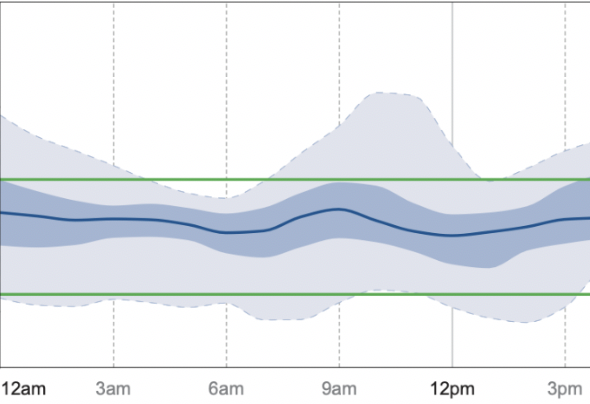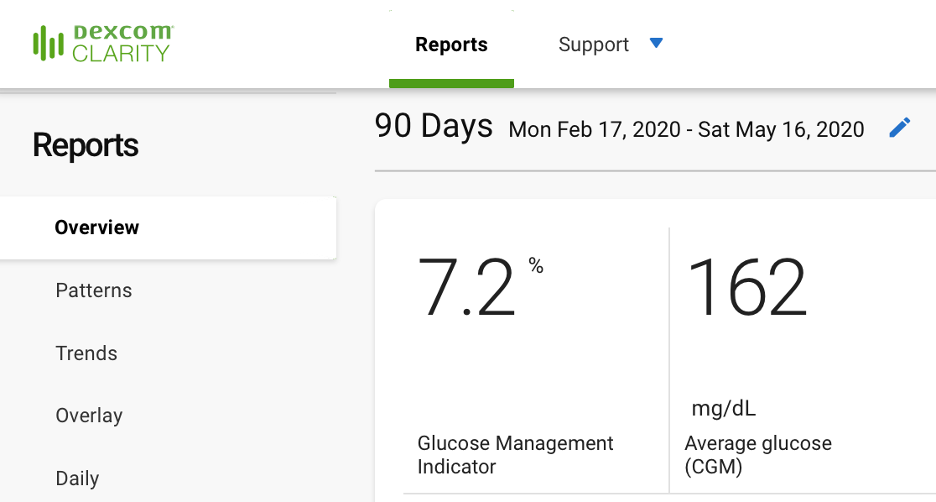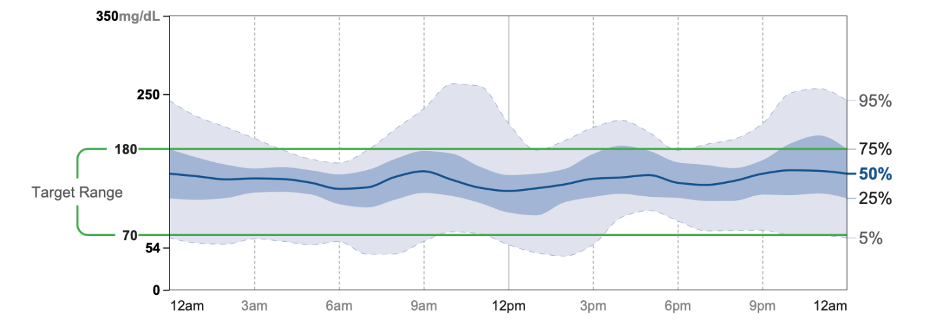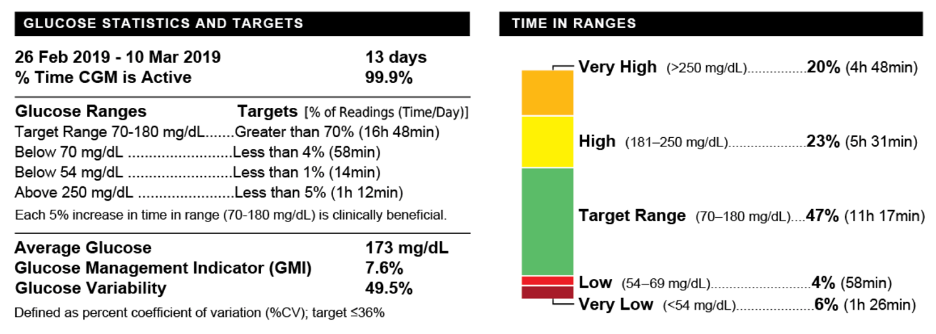Going Beyond A1C: Improve Your Health with GMI and TIR
 By Mark Harmel
By Mark Harmel
Mark Harmel, a Diabetes Care and Education Specialist, discusses the value of CGM reports, specifically the Glucose Management Indicator (GMI) and time in range (TIR)
Since the A1C test was developed in the 1970s, people with diabetes have had to go to their doctor's office to get the test and see what their average blood sugars were. Those days are over, at least for those people who are using CGM. Our new technology produces more voluminous, revealing, and nuanced data about glucose levels than any A1C test disclosed – and that information is all at the fingertips of the individual. And if properly understood, that information can be used to construct a management plan to improve diabetes care.
With diabetes management moving to telemedicine, many people with diabetes are asking, "How do I get an A1c?" But even before this pandemic, a number of leading researchers and clinicians were questioning the clinical value of the A1c, as it can be misleading based on genetic variability and certain medical conditions. The A1c also disclosed nothing about important glucose fluctuations. We see people with diabetes with a gently undulating 150 mg/dl glucose average who have the same A1c as a person with a glucose bouncing like a yo-yo between 50 and 350 mg/dl.
It was even commonplace in the clinic to question the results generated by the A1c machine compared to what people with diabetes and providers were seeing on CGM reports. To be sure, the A1c will continue to be useful for research purposes and as a marker for long-term complications, but with widespread continuous glucose monitoring available, we have more data to help people with diabetes manage their diabetes.
For our telemedicine visits, we are using a new metric called the glucose management indicator, or GMI, that is available in many CGM reports. This is a good indicator of the A1c, as it is determined by the average glucose value entered into a formula that generates an equivalent of an A1c. The calculator is available at the Jaeb Center website.
The Dexcom Clarity report can easily generate a 90-day average sensor glucose value, and this GMI is the closest equivalent to the three-month blood glucose concentration. Other software will simply give you a GMI, or average glucose, over a two or four-week period, and that can give you a good idea of your A1c estimate.
 Clarity allows you to easily select a time range of 90 days to generate an average CGM glucose and Glucose Management Indicator that is an equivalent to an A1c.
Clarity allows you to easily select a time range of 90 days to generate an average CGM glucose and Glucose Management Indicator that is an equivalent to an A1c.
What Do All of These Other Numbers Mean?
While meeting with a person with diabetes, the GMI (or A1c) can still be the headline, but that is history, and we are meeting to talk about the future. How can we understand the current diabetes treatment regimen and behavior that are generating the numbers, and can we devise a plan for improvement?
The first step is for the provider and person with diabetes to view the reports together. Moving to telemedicine actually makes this step easier. Screen sharing allows us to view the reports at the same time, and for many people with diabetes I'm revealing the unseen mysteries of their CGM and pump data. They see the squiggles of the daily glucose tracings and the boxes of numbers on the reports, but unlike educating about an overall A1C goal of 7%, we haven't stressed the importance of new data in the Ambulatory Glucose Profile (AGP) report, that allows us to create a more personalized diabetes management plan.
Time In Range
Each CGM, meter, and pump company still present their data in a different way, but there is agreement on standardized ranges to display user data. The target is to increase the time in range (TIR) between 70-180 mg/dl. This is the Goldilocks zone that is neither too high nor too low. Above that are the high (180-250 mg/dl) and very high (above 250 mg/dl) zones and the low (54 - 69 mg/dl) and very low (below 54 mg/dl) ranges.
Keeping your glucose level in the 70-180 mg/dl target range 70% of the time will translate to an A1c of 7% or less. This is also the range that participants achieved in the recent clinical trial of the Tandem Control-IQ software. We are finding that the more dedicated early adopters of the pump have TIR numbers in the 80% range and above. Whatever your percentage is now, the goal is to have more of your glucose numbers in the TIR category.
 A cloud report that displays the time in the target range plus above and below periods.
A cloud report that displays the time in the target range plus above and below periods.
Looking outside the TIR target, we next work to reduce the time spent in the very low and the low categories to less than 3%. A short dip into the 65 mg/dl and back up is less concerning than a rapid plunge down to 50 mg/dl that can often produce an over correction. Even more troubling are prolonged lows in the middle of the night. These lows can be reduced by setting CGM alarms or by using a hybrid closed-loop pump.
Spending time in the very high number range above 250 mg/dl - especially for long periods of time - is the biggest contributor to an elevated A1c and increased risk of long-term complications. We worry less about the short post-meal excursions that peak around 220 mg/dl and return to the TIR zone.
No matter what your current TIR distribution, the goal is to move the numbers more in the 70 -180 mg/dl target while having fewer lows and extreme highs.
 A sample TIR chart with the ranges defined and a set of target numbers.
A sample TIR chart with the ranges defined and a set of target numbers.
Glucose Variability
Glucose variability is the ups and downs of diabetes; these can be seen in the small thumbnail representations of your individual days in your AGP or pump report. How do they look? Do you see more days that look like rollercoasters or speedbumps? The CGM stat geeks have been arm-wrestling over how to define this up and down variability, and most of them are now focusing on what is called the coefficient of variation; and the goal is to have a number less than 36%.
Take a look at your thumbnails and identify the days that look more like speedbumps and consider what you did and try to have more days of gentle waves.
 Review the thumbnails in your reports and look for the times or days of less variation and try to learn from your success.
Review the thumbnails in your reports and look for the times or days of less variation and try to learn from your success.
With the availability of GMI, TIR and variability profiles, people with diabetes using CGM have less need for an A1c. The details in these reports provide information we can review together, and we can construct a plan to prevent lows and to reduce highs while having less variability and more time in the target range of 70-180 mg/dl.
Now that you are being asked to download a device or upload to the cloud, stop and take a look at the numbers and ask your provider or educator to review them with you to help you understand the reports, which will improve your diabetes care.
Glossary:
-
A1c/HbA1c: or hemoglobin A1C, reflects the average levels of blood glucose over approximately 3 months
-
GMI: Glucose management Indicator - The average expected A1C level from at least 14 days of CGM data.
-
TIR: Time in Range or the percentage of time spent in the target glucose range or between 70 - 180 mg/dl. There is also the time above and below target range.
-
AGP: Ambulatory Glucose Profile, a standardized, single page glucose report.
This article is part of a series on time in range.
The diaTribe Foundation, in concert with the Time in Range Coalition, is committed to helping people with diabetes and their caregivers understand time in range to maximize patients' health. Learn more about the Time in Range Coalition here.
About Mark
Mark Harmel, MPH, CDCES (CDE) is the Clinical Research Coordinator and Diabetes Care & Educational Specialist at the USC Westside Center for Diabetes.







